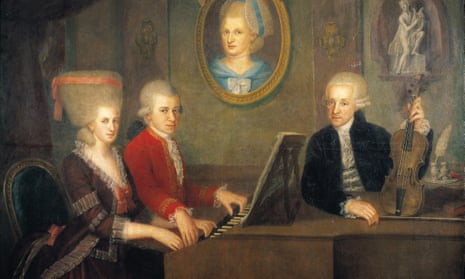
Wolfgang Amadeus Mozart and his sister, Maria Anna, who was also a child musical prodigy, at the piano.
Photograph: Imagno/Getty Images
Two siblings, both considered child prodigies, dazzled audiences across Europe together in the 18th century, leaving a trail of positive reviews in their wake. But while Wolfgang Amadeus Mozart went on to be celebrated as one of the world’s greatest composers, the accomplishments of his sister – Maria Anna – were quickly forgotten after she was forced to halt her career when she came of age.
However, a new tool is seeking to cast a spotlight on female composers throughout the ages, pushing back against the sexism, stigmatisation and societal norms that have long rendered them invisible.
“We’ve never given them the place they deserve in history,” said Sakira Ventura, the creator of an interactive map that features more than 500 female composers from across the globe. “They don’t appear in musical history books, their works aren’t played at concerts and their music isn’t recorded.”
The 28-year-old music teacher from Valencia came up with the idea after realising that during her years of academic studies of music, she had rarely heard of women who had composed classical music. “I had always talked about putting these composers on the map – so it occurred to me to do it literally.”
Then came the hard part. “There’s a moment where you ask yourself, where do I look for this information?” She delved into encyclopedias, dug through libraries and contacted people on social media.

The interactive map features more than 500 female composers from across the globe
Photograph: https://svmusicology.com/mapa/
“When I started I thought I wouldn’t know more than five female composers,” she said. After more than a year and hundreds of hours of work, the site documents 530 composers – including a short description of each one and a link to listen to their work – and Ventura is working her way through a list of another 500 names to add.
The result is a catalogue of artists that range from Kassia, a Byzantine abbess born in 810 and whose hymns are still sung in the Orthodox church, to Alma Deutscher, the British teenager who composed her first piano sonata at the age of six.
Many of the women listed on the map languished in obscurity, their careers marred by the long-held notion that music could be a pastime for women but not a profession. Some, like Maria Anna Mozart, nicknamed Nannerl, saw their careers come to an abrupt halt amid concerns that performing and touring could put her reputation at risk. Others were stigmatised by the belief, stubbornly clung to for centuries, that women were incapable of the kind of higher level thinking needed to compose.

“It was taken for granted that a work composed by a woman wouldn’t be of the same quality as that composed by a man,” said Ventura. The barriers forced female composers to get creative; some enrolled in convents in order to study music while others published works under male pseudonyms.
Much of the reaction to the map has been positive, said Ventura, save for the few voices that have complained about the absence of men on the map. “I have to explain to them that if they want to find out about male composers, they can open any book on music history, go to any concert or tune into any radio station,” she said. “But if I’m putting together a map of female composers, it is because these women don’t appear anywhere else.”
What’s excited her most is the interest she has received from other teachers who are eager to incorporate the map into their lessons. “I’m 28 years old and nobody ever spoke to me about female composers,” she said. “So I want to do what hasn’t [been] done for me, I want my students to know that [Wolfgang Amadeus] Mozart and Beethoven existed but also that there were also all these female composers.”
